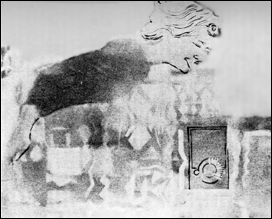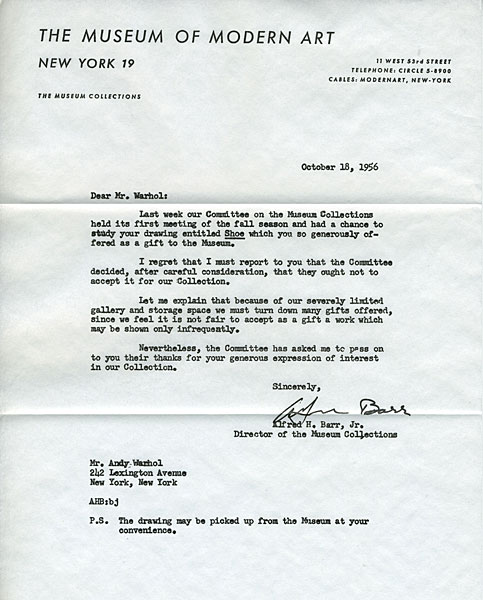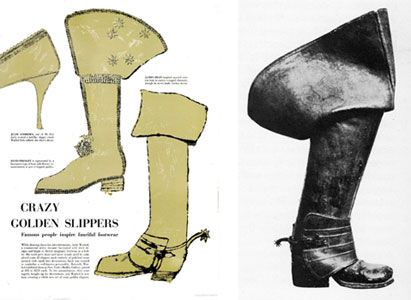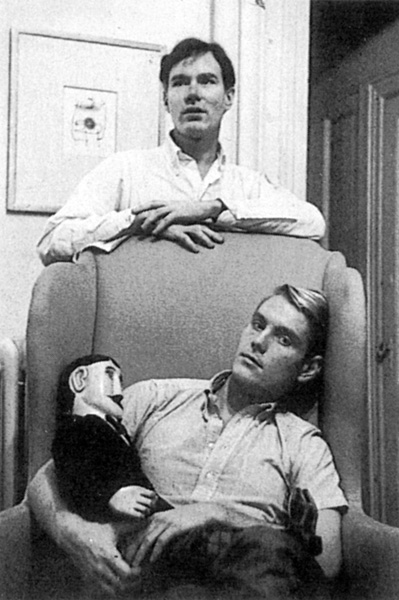Andy Warhol: From Nowhere to Up There
an oral history of Andy Warhol's early years
by Gary Comenas
page twenty-three
Patrick S. Smith: Sometime in 1956 Warhol exhibited one of his paintings of this period. Sponsored by the Radio Advertising Bureau of New York, the exhibit ‘Art for Radio’ included Warhol’s painting Rock & Roll. (PS20)
Vito Giallo: We had a big radio account, the Radio Advertising Bureau. And Andy did this one. There are some people in here [a brochure for the show ‘Art for Radio’] and were part of that Loft [Gallery] group. (PSC51)

Andy Warhol, Rock & Roll, c. 1956 Oil on canvas – whereabouts unknown © A.D.A.G.P. Paris/V.A.G.A., New York, 1986 (PS21)
Patrick S. Smith: The exhibition Art for Radio was sponsored by the Radio Advertising Bureau, Inc., New York. The show was apparently seen in the bureau’s headquarters, and it was not reviewed. Designed to promote the broadcasting medium during the early years of American television, the exhibit was coordinated by Jack Wolfgang Beck and was juried by Frank O’Hara, Raymond Dowden of the Cooper Union and William Atkin of Reinhold Publishing Corp. There were 20 artists who exhibited, including Ernest R. Smith, Arno Sternglass and Sheldon Cotler who won the three prizes, as well as Vito Giallo and Warhol. (PS536n.58)
Tony Scherman/David Dalton: Warhol [also] cracked the Museum of Modern Art in 1956, when a shoe drawing was included in the museum's 'Recent Drawings U.S.A.' show [see beginning of chapter]. Andy offered the drawing to the Modern's permanent collection [in October 1956], receiving a polite no from the museum's director, Alfred Barr.

Warhol's rejection letter from the Museum of Modern Art for his drawing, Shoe.
Heiner Bastian: In December 1956, after returning from a trip round the world with his friend Charles Lisanby, Warhol showed the most remarkable of his shoe drawings in the Bodley Gallery. He coloured the body of the shoes with applied (imitation) gold leaf and added fanciful gold and silver decorations, as in children's poetry albums. (HB20)
[Note: Warhol had returned from his trip with Lisanby on 12 August - see itinerary earlier in this chapter. The "Andy Warhol: The Golden Slipper Show or Shoes Shoe in America" took place at the Bodley Gallery from December 3 to 22, 1956. ]
Charles Lisanby: ...the whole gold leaf thing... was also a result of our trip because in Siam or Thailand in one of the museums there, he [Warhol] saw those marvelous pieces of furniture with gold leaf, and then, painting black, leaving areas of gold leaf showing. It is a typical Siamese type of decoration... and that - since he already had the black line, the blotted-line, he thought of adding the gold leaf. In fact, he did these things, all of these things, shortly after that [trip]. (PS369)
Nathan Gluck: Andy didn't really use gold leaf. Actually, it was bronze leaf, called 'Dutch metal.' He would use sobo - a glue, an adhesive from milk products, bought in an art supply store. There was an exhibition of them ["Andy Warhol: The Golden Slipper Show or Shoes Shoe in America"] and a spread in Life magazine, then someone gave him a bunch of wooden lasts to which we would glue wooden heels and decorate them. And sometimes I'd throw down some fake blotted drawings on them and put tinsel on them. (PS319)
Rainer Crone: The best known of Warhol's works with calligraphic inscriptions from the mid-1950s are the shoe collages... representing more or less critical portraits of leading public figures, movie stars, and Warhol's friends, the 'personified shoes.' Obviously there are close affinities between Grandville's personified flowers, which Warhol was familiar with from 1955 at the latest, and his personified shoes.
Especially in American society the shoe, as an item of clothing has acquired considerable significance as a fetish object due to its symbolic nature... above all, the shoe has a place in the folklore of North America, as a symbol of fertility, love, and the vulva...
The best-known reference to women’s shoes as a substitute fetish for a phallic symbol comes from Freud’s Leonardo da Vince: A Study in Psychosexuality (published in English in 1947). Freud went so far as to explain the fetishistic veneration of women’s shoes as a sign of homosexuality, and the shoe that is placed by the fireplace in some countries in place of a stocking on Saint-Nicholas Day recalls the legend of Saint Nicholas, who distributed money to girls who had been forced to earn a living through prostitution. (RCA63-64)
Sigmund Freud (from Leonardo da Vinci: A Psychosexual Study of an Infantile Reminiscence (London: Kegan Paul, Trench, Trubner & Co. Ltd, 1922), pp. 57-58): Before the child came under the domination of the castration complex, at the time when he still held the woman at her full value, he began to manifest an intensive desire to look as an erotic activity of his impulse. He wished to see the genitals of other persons, originally probably because he wished to compare them with his own. The erotic attraction which emanated from the person of his mother soon reached its height in the longing to see her genital which he believed to be a penis. With the cognition acquired only later that the woman has no penis, this longing often comes transformed into its opposite and gives place to disgust, which in the years of puberty may become the cause of psychic impotence, of misogyny and of lasting homosexuality. But the fixation on the once so vividly desired object, the penis of the woman, leaves ineradicable traces in the psychic life of the child, which has gone through that fragment of infantile sexual investigation with particular thoroughness. The fetich-like reverence for the feminine foot and shoe seems to take the foot only as a substitutive symbol for the once revered and since then missed member of the woman.
Trevor Fairbrother: Warhol first reached a national audience as an artist in his own right when Life [magazine] in January 1957 carried a double spread of his shoe collages symbolizing well-known personalities… Featured at Serendipity, then the Bodley Gallery and then in Life, Warhol’s allegorical shoe portraits were his most successful creations of the 1950s. (TR64)

Left: Life Magazine (21 January 1957, p. 13 featuring James Dean boot/Right: Illustration of a mid-18th century boot from The Romance of the Shoe, Being the History of Shoemaking in All Ages, and Especially in England and Scotland (London 1922)
Parker Tyler (Art News review, December 1956): Naively outlined in strict profile and then, as if were, smothered in gold-leaf and decorative commercial cut-outs in gold… they have an odd elegance of pure craziness. (TR66-67/PT59)
Fred Lawrence Guiles: In 1957, Dick Banks, Andy's old colleague from I. Miller Shoes, introduced Andy to the most important friend he would have in the fifties, after Lisanby. Ted Carey was a strikingly handsome, blond scion of a limousine-for-hire empire. Although had had family money behind him (to buy art works, for example), Carey worked to support himself as a commercial artist in textile design. (FG130)
Richard ('Dick') Banks: Ted [Carey] was my lover, and he liked Andy's work. We all admired it... And Andy came over Sundays to draw me when I lived around the corner from him on Lex. I know a lot of celebrities, and Andy got very excited about this. Through Carl Van Vechten, I had just met half of the world. I knew Tallulah, and Mabel Mercer was my great friend, Gloria Swanson, Aileen Pringle, all of the ballet dancers... (FG130)

Andy Warhol and Ted Carey (Photographer unknown) (AWMU174)
Fred Lawrence Guiles: On a nice day, Andy and Ted would sit at a table in the Central Park Zoo cafeteria, a fairly respectable spot, to watch people go by. Cruising gays often spilled over into the cafeteria area from their usual turf on the west side of the Park. While Andy may well have given up competing in the 'marketplace,' he liked to be out where 'the beauties,' as he called them, were promenading....
If Andy asked one of these 'beauties' to pose for him and the three of them went off together, predictably, the drawing session would turn sexual between Cary and the stranger, but that was fine, too, with Andy. He participated with his sketchpad and no longer skittered away when such a scene developed. A friend of Andy's in the early sixties, Buzz Miller, said that such trios became commonplace in Andy's life - Ted and the pick-up in bed and Andy nearby sketching the scene. (FG156)
Calvin Tomkins: Andy lost the I. Miller account about this time. A new art director had come in and decided to change the I. Miller image, and since Andy was totally responsible for the image, that meant bye-bye Andy. His income dropped a little as a result, although he was still making more than almost any other illustrator in the business. (CT12)
Patrick S. Smith: ... I. Miller was bought in 1957 by Genesco, Inc., which changed I. Miller's personnel. (PSC101)
Geraldine Stutz: Well, two years was a long time for a single campaign... don't forget, I left Miller, Palazzo left Miller with me, and we were the two creative people involved. (PSC106)
Charlie Scheips (curator): In 1957, Warhol created a golden Christmas tree illustration for the [Harper's Bazaar] magazine’s December issue. It served also to publicize his exhibition that month at New York’s Bodley Gallery entitled 'A Show of Golden Pictures.' (AM4)